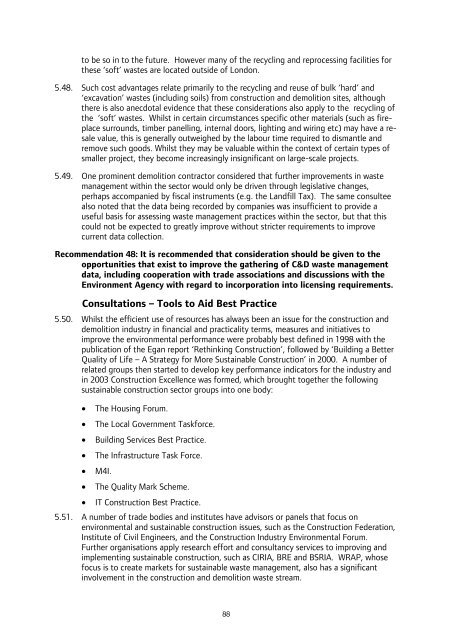London Wider Waste Strategy - London - Greater London Authority
London Wider Waste Strategy - London - Greater London Authority
London Wider Waste Strategy - London - Greater London Authority
You also want an ePaper? Increase the reach of your titles
YUMPU automatically turns print PDFs into web optimized ePapers that Google loves.
to be so in to the future. However many of the recycling and reprocessing facilities for<br />
these ‘soft’ wastes are located outside of <strong>London</strong>.<br />
5.48. Such cost advantages relate primarily to the recycling and reuse of bulk ‘hard’ and<br />
‘excavation’ wastes (including soils) from construction and demolition sites, although<br />
there is also anecdotal evidence that these considerations also apply to the recycling of<br />
the ‘soft’ wastes. Whilst in certain circumstances specific other materials (such as fireplace<br />
surrounds, timber panelling, internal doors, lighting and wiring etc) may have a resale<br />
value, this is generally outweighed by the labour time required to dismantle and<br />
remove such goods. Whilst they may be valuable within the context of certain types of<br />
smaller project, they become increasingly insignificant on large-scale projects.<br />
5.49. One prominent demolition contractor considered that further improvements in waste<br />
management within the sector would only be driven through legislative changes,<br />
perhaps accompanied by fiscal instruments (e.g. the Landfill Tax). The same consultee<br />
also noted that the data being recorded by companies was insufficient to provide a<br />
useful basis for assessing waste management practices within the sector, but that this<br />
could not be expected to greatly improve without stricter requirements to improve<br />
current data collection.<br />
Recommendation 48: It is recommended that consideration should be given to the<br />
opportunities that exist to improve the gathering of C&D waste management<br />
data, including cooperation with trade associations and discussions with the<br />
Environment Agency with regard to incorporation into licensing requirements.<br />
Consultations – Tools to Aid Best Practice<br />
5.50. Whilst the efficient use of resources has always been an issue for the construction and<br />
demolition industry in financial and practicality terms, measures and initiatives to<br />
improve the environmental performance were probably best defined in 1998 with the<br />
publication of the Egan report ‘Rethinking Construction’, followed by ‘Building a Better<br />
Quality of Life – A <strong>Strategy</strong> for More Sustainable Construction’ in 2000. A number of<br />
related groups then started to develop key performance indicators for the industry and<br />
in 2003 Construction Excellence was formed, which brought together the following<br />
sustainable construction sector groups into one body:<br />
• The Housing Forum.<br />
• The Local Government Taskforce.<br />
• Building Services Best Practice.<br />
• The Infrastructure Task Force.<br />
• M4I.<br />
• The Quality Mark Scheme.<br />
• IT Construction Best Practice.<br />
5.51. A number of trade bodies and institutes have advisors or panels that focus on<br />
environmental and sustainable construction issues, such as the Construction Federation,<br />
Institute of Civil Engineers, and the Construction Industry Environmental Forum.<br />
Further organisations apply research effort and consultancy services to improving and<br />
implementing sustainable construction, such as CIRIA, BRE and BSRIA. WRAP, whose<br />
focus is to create markets for sustainable waste management, also has a significant<br />
involvement in the construction and demolition waste stream.<br />
88
















